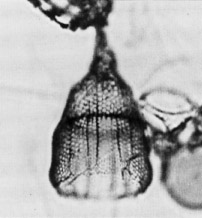 Pterocorys
hertwigii (Haeckel)
Pterocorys
hertwigii (Haeckel) Pterocorys
hertwigii (Haeckel)
Pterocorys
hertwigii (Haeckel)Eucyrtidium hertwigii Haeckel, 1887, p.1491, pl.80, fig.12
Pterocorys hertwigii (Haeckel), Caulet and Nigrini, 1988, p.229, pl.1, figs.11-12 (with synonymy)
Shell conical to ovate, thin-walled, smooth except for longitudinal ridges at irregular intervals. Cephalis trilocular with numerous subcircular pores, heavier than rest of shell. Stout three-bladed apical horn usually about the same length or a little longer than cephalis. Primary lateral and dorsal spines aligned with the ribs in the thoracic wall.
Thorax campanulate with subcircular pores arranged in longitudinal rows. Lumbar stricture distinct. Abdomen broader than thorax, but with similar pores. In complete specimens abdomen slightly constricted distally with a smooth termination, but most specimens are incomplete.
Both thorax and abdomen ornamented by poreless ridges that run more or less longitudinally, irregularly spaced and not necessarily continuous for entire shell length. On the thorax some of the ridges frequently bear 1 or 2 small spines (Nigrini, 1967).
Total length (excluding apical horn) 119-191 µm. Length of apical horn 2-45 µm; of cephalis 23-32 µm; of thorax 45-63 µm; of abdomen up to 109 µm. Maximum breadth of cephalis 27-32 µm; of thorax 81-100 µm; of abdomen 100-136 µm (Nigrini, 1967).
Shell generally conical, with distinct collar and lumbar strictures. Wall of thorax and abdomen thin, with pores longitudinally aligned, and more than three thin, longitudinal ribs not necessarily continuous throughout thorax and abdomen. No differentiated peristome (Riedel and Sanfilippo, 1978a).
Extant. Few to common in the tropical Pacific Ocean, but rare in the tropical Indian Ocean. It does not occur in samples from south of 35°S. Its morphotypic first appearance is a synchronous event, which lies within the Amphirhopalum ypsilon Zone.